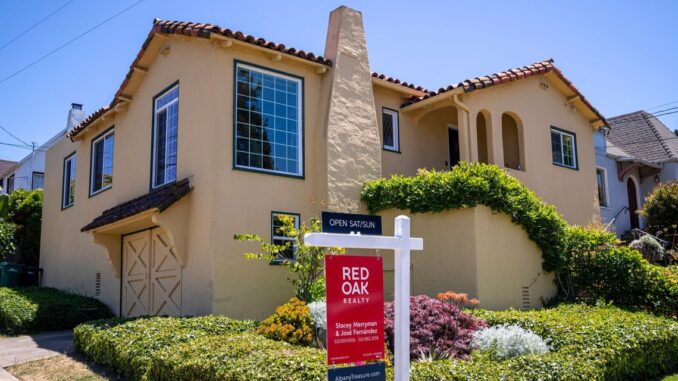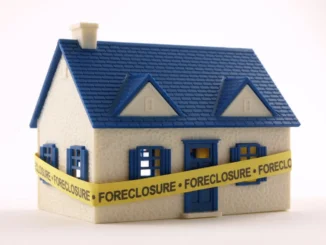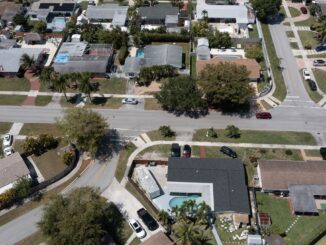
The average rate on a 30-year fixed mortgage surged nearly a quarter-point to 6.96% this week, looming closer to the 7% benchmark that hasn’t been reached since November. This marks the third consecutive week of significant mortgage rate increases, which have erased most of the downward progress made in early 2023.
Mortgage rates ascended higher on most home loan terms, including both fixed-rate and adjustable-rate mortgages. Volatile interest rates are causing uncertainty ahead of a typically busy spring homebuying season. Here are the current mortgage rates, without discount points unless otherwise noted, as of Feb. 23:
- 30-year fixed: 6.96% (up from 6.73% a week ago).
- 20-year fixed: 6.93% (up from 6.77% a week ago).
- 15-year fixed: 6.21% (up from 6.02% a week ago).
- 10-year fixed: 6.31% (up from 5.97% a week ago).
- 5/1 ARM: 5.54% (up from 5.43% a week ago).
- 7/1 ARM: 5.67% (down from 5.7% a week ago).
- 10/1 ARM: 6% (up from 5.9% a week ago).
- 30-year jumbo loans: 6.98% (up from 6.78% a week ago).
- 30-year FHA loans: 6.2% with 0.05 point (up from 5.98% a week ago).
- VA purchase loans: 6.28% with 0.05 point (up from 6.08% a week ago).

Mixed economic signals on stubborn inflation and a resilient labor market may cause Federal Reserve policymakers to reevaluate their plan to slow the pace of benchmark rate hikes in 2023. So far, Fed officials have been waiting to see next month’s consumer price index report before making any announcement of larger and faster rate hikes. And in the meantime, rates are not expected to decline significantly.
“This means that the housing market will continue to be a ‘nobody’s market’ – not friendly to buyers nor to sellers,” Xu says.
As home prices and mortgage rates remain high compared with one year ago, homebuyer demand is stifled by affordability. Existing-home sales retreated for the 12th consecutive month in January, according to Realtor.com, as the inventory of homes for sale remains below pre-pandemic levels.
Indicator of the Week: Inventory Lags as Sellers Stay Put
The number of active listings of homes for sale has been steadily decreasing since September, with housing inventory currently much lower than it was before the COVID-19 pandemic, according to a market report from the real estate company Zillow. The housing market added just 230,000 new listings in January, which is by far the lowest monthly increase since Zillow began tracking this data in 2018. The supply of homes for sale is now nearly as low as it was when mortgage rates were at about 3%.
With higher mortgage rates significantly impacting homebuying demand, one would think that inventory would be rising, not declining. But potential sellers are reluctant to list their homes, unwilling to trade in their record-low mortgage rates for current rates near 7%. Inventory is typically expected to rise during the busy spring homebuying season, which could help balance the market, but recent mortgage rate volatility has made the outlook murkier.
“The risk for sellers waiting till April or May to list is that no one knows what mortgage rates will do in the meantime,” says Zillow senior economist Jeff Tucker in the report. “Buyers may return to hibernation if last month’s mortgage-rate thaw turned out to be a false spring.”

ERIKA GIOVANETTI
Still, prospective buyers don’t need to worry about the cutthroat bidding wars seen when mortgage rates were at historic lows. The number of homes for sale may be constricted, but so is demand among buyers – especially if rates continue rising at this month’s breakneck pace.
“Now as a buyer, you can slow down, have your inspection and make a strong, well-informed offer,” says Ryan Platzke, a Zillow member real estate agent based in Minneapolis.
While sellers shouldn’t expect to receive an influx of all-cash offers with no contingencies, as seen during 2021 and early 2022, Zillow still predicts competition for “well-priced houses” will remain stronger than it was before the pandemic. But the competition will be healthier, without the worry of bidding wars driving home sales prices well above appraised values.
Going into the spring, mortgage rates will be the real wild card. If they recede back closer to 6%, more buyers may reenter the market. But if rates continue climbing to 7% and beyond, prospective homebuyers may decide to wait it out in the rental market.



